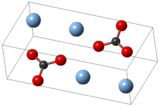
| |

| |
| Names | |
|---|---|
| IUPAC name
Silver(I) carbonate
| |
| Other names
Argentous carbonate
| |
| Identifiers | |
3D model (JSmol)
|
|
| ChemSpider | |
| ECHA InfoCard | 100.007.811 |
| EC Number |
|
| MeSH | silver+carbonate |
PubChem CID
|
|
| UNII | |
CompTox Dashboard (EPA)
|
|
| |
| |
| Properties | |
| Ag2CO3 | |
| Molar mass | 275.75 g/mol |
| Appearance | Pale yellow crystals |
| Odor | Odorless |
| Density | 6.077 g/cm3[1] |
| Melting point | 218 °C (424 °F; 491 K) decomposes from 120 °C[1][4] |
| 0.031 g/L (15 °C) 0.032 g/L (25 °C) 0.5 g/L (100 °C)[2] | |
Solubility product (Ksp)
|
8.46·10−12[1] |
| Solubility | Insoluble in ethanol, liquid ammonia, acetates, acetone[3] |
| −80.9·10−6 cm3/mol[1] | |
| Structure | |
| Monoclinic, mP12 (295 K) Trigonal, hP36 (β-form, 453 K) Hexagonal, hP18 (α-form, 476 K)[5] | |
| P21/m, No. 11 (295 K) P31c, No. 159 (β-form, 453 K) P62m, No. 189 (α-form, 476 K)[5] | |
| 2/m (295 K) 3m (β-form, 453 K) 6m2 (α-form, 476 K)[5] | |
a = 4.8521(2) Å, b = 9.5489(4) Å, c = 3.2536(1) Å (295 K)[5] α = 90°, β = 91.9713(3)°, γ = 90°
| |
| Thermochemistry | |
Heat capacity (C)
|
112.3 J/mol·K[1] |
Std molar
entropy (S⦵298) |
167.4 J/mol·K[1] |
Std enthalpy of
formation (ΔfH⦵298) |
−505.8 kJ/mol[1] |
Gibbs free energy (ΔfG⦵)
|
−436.8 kJ/mol[1][4] |
| Hazards | |
| Occupational safety and health (OHS/OSH): | |
Inhalation hazards
|
Irritant |
| GHS labelling:[7] | |
 
| |
| Danger | |
| H315, H319, H335 | |
| P261, P305+P351+P338 | |
| NFPA 704 (fire diamond) | |
| Lethal dose or concentration (LD, LC): | |
LD50 (median dose)
|
3.73 g/kg (mice, oral)[6] |
Except where otherwise noted, data are given for materials in their standard state (at 25 °C [77 °F], 100 kPa).
| |
Silver carbonate is the chemical compound with the formula Ag2CO3. This salt is yellow but typical samples are grayish due to the presence of elemental silver. It is poorly soluble in water, like most transition metal carbonates.
- ^ a b c d e f g h Lide, David R., ed. (2009). CRC Handbook of Chemistry and Physics (90th ed.). Boca Raton, Florida: CRC Press. ISBN 978-1-4200-9084-0.
- ^ Seidell, Atherton; Linke, William F. (1919). Solubilities of Inorganic and Organic Compounds (2nd ed.). New York City: D. Van Nostrand Company. p. 605.
- ^ Comey, Arthur Messinger; Hahn, Dorothy A. (February 1921). A Dictionary of Chemical Solubilities: Inorganic (2nd ed.). New York: The MacMillan Company. p. 203.
- ^ a b Anatolievich, Kiper Ruslan. "silver nitrate". chemister.ru. Retrieved 2014-07-21.
- ^ a b c d Norby, P.; Dinnebier, R.; Fitch, A.N. (2002). "Decomposition of Silver Carbonate; the Crystal Structure of Two High-Temperature Modifications of Ag2CO3". Inorganic Chemistry. 41 (14): 3628–3637. doi:10.1021/ic0111177. PMID 12099865.
- ^ a b "Silver Carbonate MSDS". saltlakemetals.com. Salt Lake City, Utah: Salt Lake Metals. Retrieved 2021-08-05.
- ^ Sigma-Aldrich Co., Silver carbonate. Retrieved on 2021-08-05.
